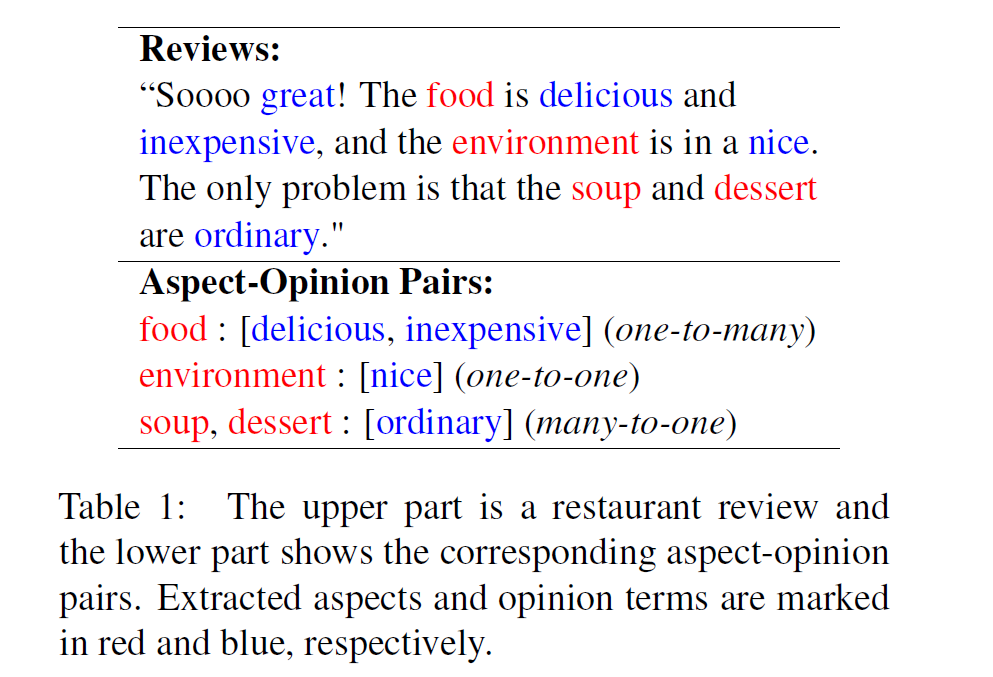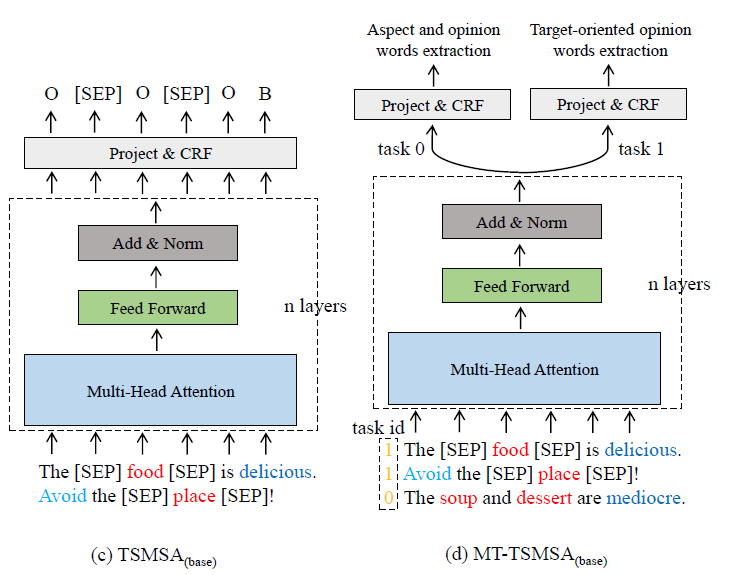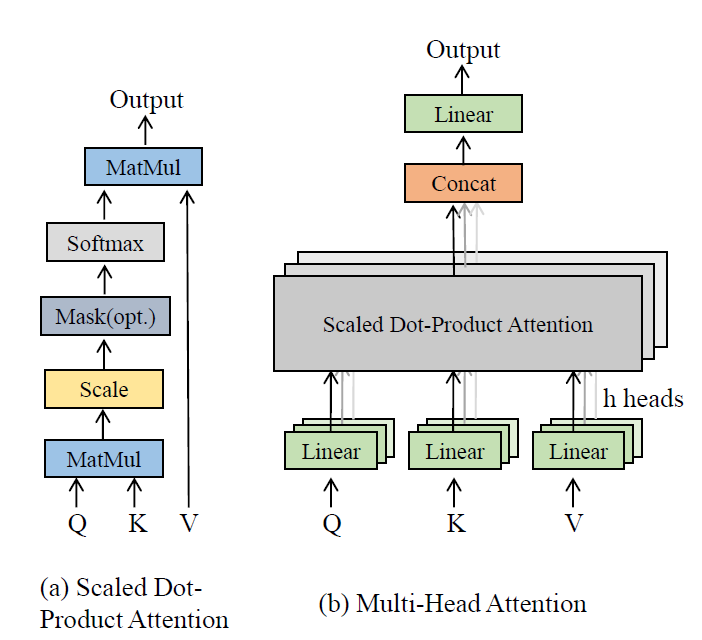Target-specified Sequence Labeling with Multi-head Self-attention for Target-oriented Opinion Words Extraction (2021)
Contents
- Abstract
- Introduction
- Related Work
- TOWE
- AOPE
- Methodology
- Task Description
- Framework
- Multi-head Self-Attention
- Target-Specified Encoder
- Decoder & Training
0. Abstract
ABSA의 main task 2개
- Opinion target Extraction
- Opinion term extraction
최근의 ABSA 연구들은 TOWE!
TOWE (Target-oriented Opinion Words(Terms) Extraction )
- opinion target(=aspect)가 주어졌을 때, opinion word 맞추기
-
ex) Input : 문장 & “음식의 맛” — output : 달달하다
- 이를 추가로 AOPE로 확장 가능
AOPE (Aspect-Opinion Pair Extraction)
- extract aspect(=opinion target) & opinion terms IN PAIRS
- TOWE vs AOPE
- TOWE : aspect가 주어졌을 때, opinion word(term) 찾기
- AOPE : aspect와 opinion word(term) 을 쌍으로 찾기
이 논문은 아래의 (1) & (2)를 제안한다
- (1) TOWE를 위한 “TSMSA”
- (2) AOPE를 위한 “MT-TSMSA”
1. Introduction
용어 정리
Aspect?
-
다른 표현 : opinion target
-
word/phrase in review, referring to the object towards which users show attitudes
( ex. 음식의 맛, 공연의 가격대 )
Opinion terms
-
words or phrases representing users’ attitudes
( ex. 맵다, 짜다, 비싸다 )
Example

많은 방법론들의 문제점 :
ignore the relation of ASPECTS & OPINION TERMS
-
그래서 TOWE (Target-oriented Opinion Words Extraction) 가 필요한 것이다!
-
더 나아가서, AOPE (\(\approx\) PAOTE)가 나온 배경이기도!
-
AOPE = aspect and opinion term extraction + TOWE
( 그런데 aspect extraction은 이미 많이 연구되어서, 결국 핵심은 TOWE 이다! )
-
TOWE의 핵심 : ( 결국 AOPE의 핵심이 되겠지? )
mine the relationship between ASPECTS & OPINION TERMS
aspect & opinion term의 relationship은 복잡하다! (위의 그림 참조)
( one-to-one, one-to-many, many-to-one )
-
TSMSA ( + 기존의 TOWE 방법들의 문제점 )
-
(기존 방법들) tuning해야할 hyperparameter들이 너무 많다!
-
이 논문에서 제안하는 (TOWE 기반) 방법인 TSMSA는 이를 극복한다!
-
capable of capturing the information of the specific aspect
-
[SEP] aspect [SEP]으로 우선 전처리된다.
ex) “The [SEP] food [SEP] is delicious”
-
MT-TSMSA
- AOPE = aspect and opinion term extraction + TOWE
- MT-TSMSA는 AOPE 기반 방법
Contribution
- 1) propose a target-specified sequence labeling method with multi-head self attention to perform TOWE
- 2) TSMSA & MT-TSMSA를 위해, very little hyperparemter to tune
2. Related Works
2-1) TOWE
다양한 방법론
- 1) aspect extraction
- 2) opinion term extraction
- 3) 둘 다 동시에 ( co-extraction )
위 방법론들 모두 aspect & opinion term사이의 relationship을 무시한다
( Rule-based는 이를 고려한다 하더라도, 너무 expert knowledge에 depende해 )
TOWE ( Fan et al (2019) )
- extract opinion terms ( given aspect )
- use Inward-Outward LSTM
- 문제점 : BERT같이 파워풀한거 사용 X
- 이 논문은 BERT를 encoder로써 사용함으로서 성능 UP
2-2) AOPE
-
extract aspects & opinion terms in PAIRS
- AOPE = aspect extraction + TOWE로 나눠서 볼 수 있다
- AOPE 관련 많은 방법들, hyperparameter 너무 많아
3. Methodology
3-1) Task Description
Notation
-
sentence : \(s=\left\{w_{1}, w_{2}, \ldots, w_{n}\right\}\)
-
1) aspect ( = opinion target) : \(a=\left\{w_{i}, w_{i+1}, \ldots, w_{i+k}\right\}\)
-
2) opinion term : \(o=\left\{w_{j}, w_{j+1}, \ldots, w_{j+m}\right\}\)
( 둘 다 \(s\)의 substring이다 )
TOWE task : \(p(o \mid s, a)\)
AOPE task : \(p(<a,o> \mid s) = p(a \mid s) \times p(o \mid s,a)\)
3-2) Framework
TSMSA & MT-TSMSA의 structure는?

- step 1) aspect에 label을 붙이기 위해 “[SEP]” 을 양 옆에 사용한다
- step 2) Multi-head self attention 거쳐
- step 3) CRF 써서 sequence labeling 수행
- step 4) task 0 & task 1 are combined for multi-task learning
3-3) Multi-head Self-Attention

3-4) Target-Specified Encoder
- BERT 사용
3-5) Decoder & Training
- sequential representation \(H^{l}\)
- sequential label \(Y=\left\{y_{1}, \ldots, y_{n}\right\}\)
- \(y_{i} \in\{\mathrm{B}, \mathrm{I}, \mathrm{O},[\mathrm{SEP}]\}\). or
- \(y_{i} \in\{\mathrm{B}-\mathrm{ASP}, \mathrm{I}-\mathrm{ASP}, \mathrm{B}-\mathrm{OP}, \mathrm{I}-\mathrm{OP}, \mathrm{O}\}\).
- 위 둘을 사용하여, compute \(p\left(Y \mid H^{l}\right)\)
Single Task version
- 수식 생략 ( 그림 참조 )
- predicted output : \(p\left(Y \mid H^{l}\right)=\frac{\exp \left(S\left(H^{l}, Y\right)\right)}{\sum_{\tilde{Y} \in Y_{a l l}} \exp \left(S\left(H^{l}, \tilde{Y}\right)\right)}\).
- loss function : \(L(s)=-\log p\left(Y \mid H^{l}\right)\).
Multi Task version
-
predicted output :
- \(p\left(Y^{0} \mid H^{l}, i d=0\right)=\frac{\exp \left(S_{0}\left(H^{l}, Y^{0}\right)\right)}{\sum_{\tilde{Y} \in Y_{a l l}^{0}} \exp \left(S_{0}\left(H^{l}, \tilde{Y}\right)\right)}\).
- \(p\left(Y^{1} \mid H^{l}, i d=1\right)=\frac{\exp \left(S_{1}\left(H^{l}, Y^{1}\right)\right)}{\sum_{\tilde{Y} \in Y_{a l l}^{1}} \exp \left(S_{1}\left(H^{l}, \tilde{Y}\right)\right)}\).
-
loss function :
-
\(L(s, i d)=-\log p\left(Y \mid H^{l}, i d\right)\).
-
Given \(M\) sentences \(S=\left\{s_{1}, s_{2}, \ldots, s_{M}\right\}\) & \(i d=\left\{i d_{1}, \ldots, i d_{M}\right\}\), …
\(J(\theta)=\sum_{k=1}^{M}\left(\left(1-i d_{k}\right) \lambda+i d_{k}\right) L\left(s_{k}, i d_{k}\right)\).
-
